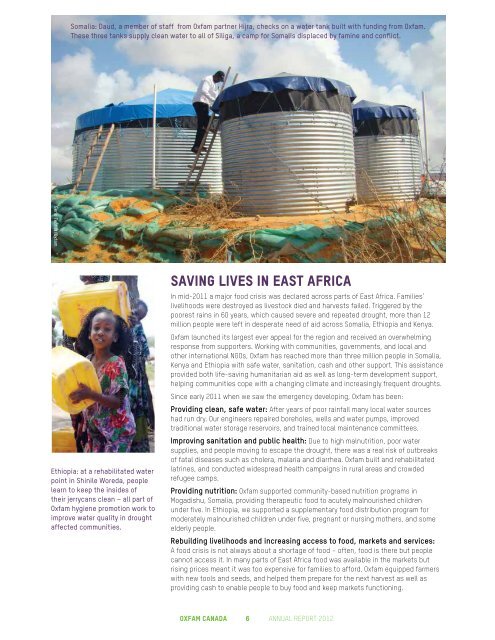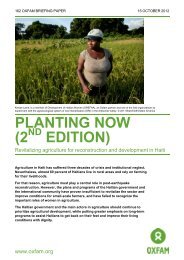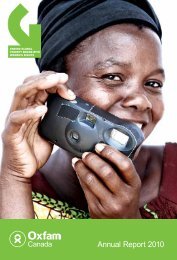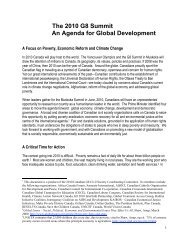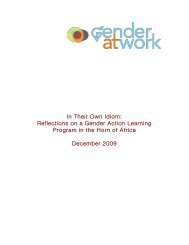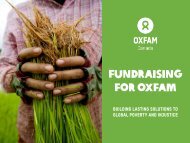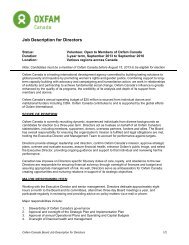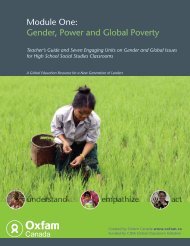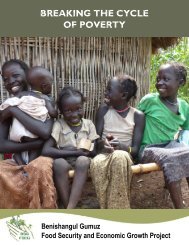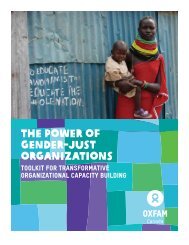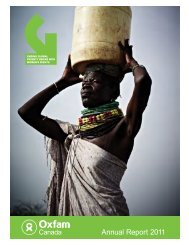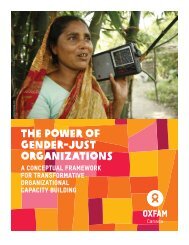Annual Report 2012 - Oxfam Canada
Annual Report 2012 - Oxfam Canada
Annual Report 2012 - Oxfam Canada
Create successful ePaper yourself
Turn your PDF publications into a flip-book with our unique Google optimized e-Paper software.
Somalia: Daud, a member of staff from <strong>Oxfam</strong> partner Hijra, checks on a water tank built with funding from <strong>Oxfam</strong>.<br />
These three tanks supply clean water to all of Siliga, a camp for Somalis displaced by famine and conflict.<br />
Geno Teofila/<strong>Oxfam</strong><br />
Tim Forster/<strong>Oxfam</strong><br />
Ethiopia: at a rehabilitated water<br />
point in Shinile Woreda, people<br />
learn to keep the insides of<br />
their jerrycans clean – all part of<br />
<strong>Oxfam</strong> hygiene promotion work to<br />
improve water quality in drought<br />
affected communities.<br />
Saving lives in East Africa<br />
In mid-2011 a major food crisis was declared across parts of East Africa. Families’<br />
livelihoods were destroyed as livestock died and harvests failed. Triggered by the<br />
poorest rains in 60 years, which caused severe and repeated drought, more than 12<br />
million people were left in desperate need of aid across Somalia, Ethiopia and Kenya.<br />
<strong>Oxfam</strong> launched its largest ever appeal for the region and received an overwhelming<br />
response from supporters. Working with communities, governments, and local and<br />
other international NGOs, <strong>Oxfam</strong> has reached more than three million people in Somalia,<br />
Kenya and Ethiopia with safe water, sanitation, cash and other support. This assistance<br />
provided both life-saving humanitarian aid as well as long-term development support,<br />
helping communities cope with a changing climate and increasingly frequent droughts.<br />
Since early 2011 when we saw the emergency developing, <strong>Oxfam</strong> has been:<br />
Providing clean, safe water: After years of poor rainfall many local water sources<br />
had run dry. Our engineers repaired boreholes, wells and water pumps, improved<br />
traditional water storage reservoirs, and trained local maintenance committees.<br />
Improving sanitation and public health: Due to high malnutrition, poor water<br />
supplies, and people moving to escape the drought, there was a real risk of outbreaks<br />
of fatal diseases such as cholera, malaria and diarrhea. <strong>Oxfam</strong> built and rehabilitated<br />
latrines, and conducted widespread health campaigns in rural areas and crowded<br />
refugee camps.<br />
Providing nutrition: <strong>Oxfam</strong> supported community-based nutrition programs in<br />
Mogadishu, Somalia, providing therapeutic food to acutely malnourished children<br />
under five. In Ethiopia, we supported a supplementary food distribution program for<br />
moderately malnourished children under five, pregnant or nursing mothers, and some<br />
elderly people.<br />
Rebuilding livelihoods and increasing access to food, markets and services:<br />
A food crisis is not always about a shortage of food – often, food is there but people<br />
cannot access it. In many parts of East Africa food was available in the markets but<br />
rising prices meant it was too expensive for families to afford. <strong>Oxfam</strong> equipped farmers<br />
with new tools and seeds, and helped them prepare for the next harvest as well as<br />
providing cash to enable people to buy food and keep markets functioning.<br />
<strong>Oxfam</strong> CANADA 6 ANNUAL REPORT <strong>2012</strong>


